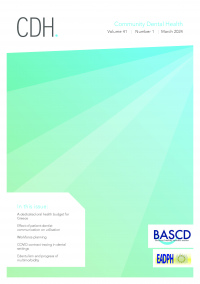December 2017
Examiner calibration in caries detection for populations and settings where in vivo calibration is not practical
Abstract
Aim: To study examiner calibration methods for populations and settings where clinical (in vivo) calibration is not practical. Methods: Study design was cross-sectional and fully-crossed. The units of analysis were 880 tooth surfaces, from ten children ages 3 to 4 years. The study had three data components: (1) Examiner training and calibration using the International Caries Detection and Assessment System (ICDAS) e-Learning programme (2) In vivo community-based visual examination and (3) Intra-oral digital photographs of the same tooth surfaces from the in vivo visual examination. Kappa and weighted kappa scores were used to study reliability estimates. Systematic differences in caries assessments were determined using the Stuart Maxwell test. Data were analysed using STATA 13.1 and SAS 9.2. Results: Weighted kappa scores for the in vivo component ranged from 0.50 to 0.66 and from 0.64-0.74, for inter- and intra-examiner reliability, respectively. Caries lesions detected in vivo were also detected on photographs, albeit with increased severity when using photographs. For example, of 46 tooth surfaces assessed as being sound in the in vivo examination, 22 (48%) of these were assessed as having caries when photographs were used as the diagnostic method. Conclusions: From this research it appears that good quality photographs alone may be used for training and calibration among challenging populations or settings without adversely affecting data quality. Key words: dental caries, calibration, photographs, epidemiology, caries detection, oral diagnosis, caries assessment




